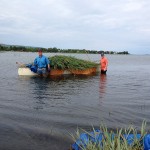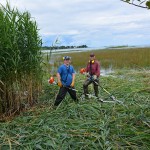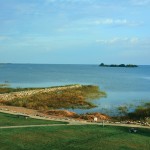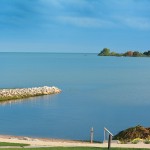Fighting phragmites at Lighthouse Point
stories by Marc Huminilowycz

Lighthouse Point resident Bruce Dodgson describes how invasive phragmites was discovered, identified and dealt with by a small group of volunteers:
“At Lighthouse Point, there is a west beach area where residents can swim, kayak and SUP. In the summer of 2014, we noticed that a small stand of what we assumed was marsh grass had grown to almost four metres tall, with nearly impenetrable bamboo-like stalks. Now, with only a two-metre-wide gap to get from the beach to open water, we realized that something had to be done.
“Thanks to two very insightful ladies from Rupert’s Landing who were experiencing a similar issue, the plant species was identified as invasive phragmites and a community meeting was held, attended by representatives from Georgian Bay Forever and the Nottawasaga Valley Conservation Authority.
“On the advice of Georgian Bay Forever, we began a program of cutting the invasive phragmites. After the first cutting, we noticed some reduction in growth a year later. Cutting the second year resulted in a marked reduction in re-growth, although some kept coming back. We realized that the solution to the phrag problem involves regular cutting to degrade the plant’s vitality, until the roots finally die.
“The process of cutting is extremely labour-intensive. You have to wade in the water, sometimes up to your waist. At first, we did all the cutting by hand, with a machete or hedge shears. For large stands of phrag this is impractical, so we now use a power cutter. To haul away the huge amount of cut phrag, we use tarps to bring it to shore, where it is thankfully picked up by the lown and composted.
“Although we have been quite successful in controlling the phrag, it has now spread to most of the shoreline in some areas. It will require a regular, concerted effort to beat this, and there’s a limit to how much a small group like ours can do. We would like to see student volunteers helping us with the annual phrag cut. It could be an educational experience for them. I also think there is an opportunity for employing students in the summer for this work. We need to explore funding options.” ❧















